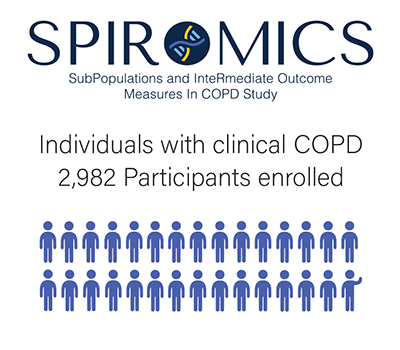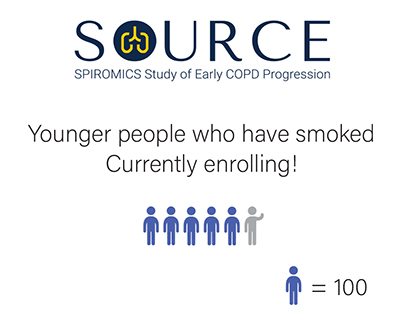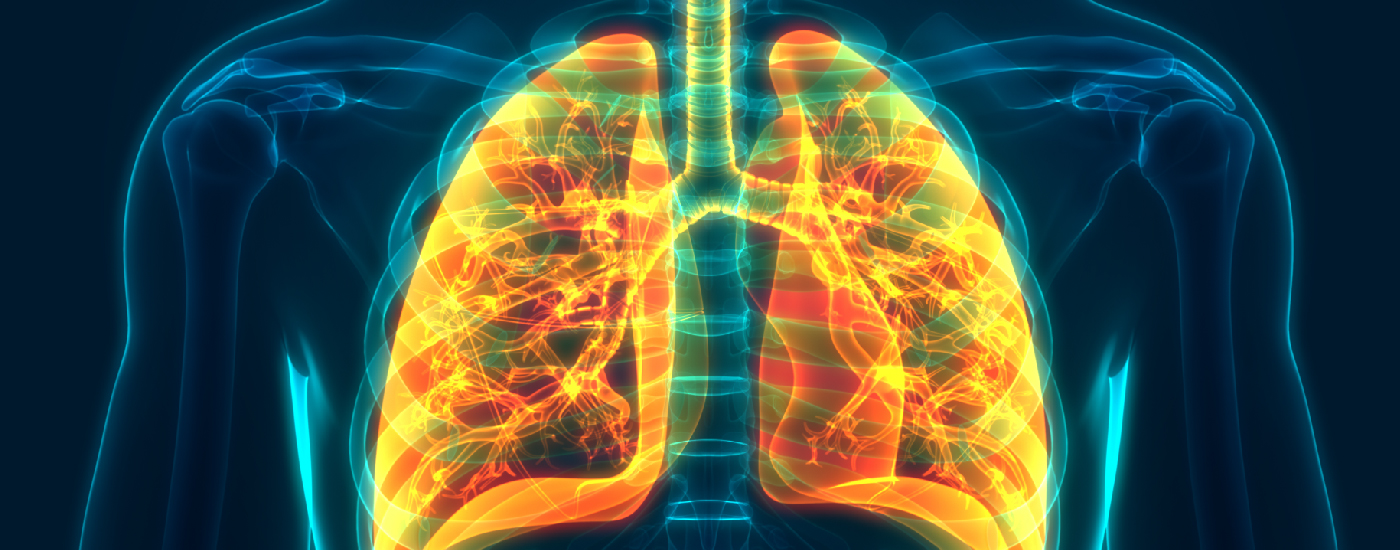SEEING THE BIG PICTURE
Our two sister studies, SPIROMICS and SOURCE, are comprehensive and connected. We’re looking at COPD at every level, inside and out, from the cellular level to the whole patient and across populations.
SPIROMICS – Subpopulations and Intermediate Outcome Measures in COPD Study
Individuals with clinical COPD
2,982 Participants enrolled.

SOURCE – SPIROMICS Study of Early COPD Progression
Younger people who have smoked
Currently enrolling!

CLINIC VISITS & PHONE CALLS
Internal factors (You)
- Medical History
- Genetics
- Medication Use
- Imaging (X-Rays, CT)
External Factors
- Outdoor & Indoor Environments
- Neighborhoods & Geography
- Social Exposures
Data from the two studies are compared to understand COPD at every stage.
HOW YOU CAN HELP:
We are currently conducting phone visits with our SPIROMICS participants, to speak with you about your lung health. The easiest way to help is to pick up the phone. We look forward to talking with you!
We are also actively recruiting for the SOURCE study, for younger people who have smoked or currently smoke. If you know someone who might be interested, they are welcome to reach out to us.
“I firmly believe that the work that we do in SPIROMICS is going to make a difference in the recognition of and treatment of COPD and related conditions. I am proud to be part of this team of physicians, scientists, and committed study participants!” Prescott Woodruff, MD, MPH, University of California San Francisco, Lead SPIROMICS Investigator
NEW SCIENCE FOR NEW DISCOVERIES
SOURCE IS LOOKING AT THE ORIGINS OF COPD
For those of you who aren’t familiar with the SOURCE research study, we are searching for the first signs of lung disease. Chronic Obstructive Pulmonary Disease (COPD) involves lung changes that start earlier than previously realized and accumulate over time. As compared to SPIROMICS, SOURCE is targeting current and former cigarette smokers between 30 and 55 years of age.
We are recruiting at the same sites as SPIROMICS so if you know someone who might be interested, please let them know! Visit the SOURCE website here.
To our existing SOURCE participants, thank you for your continued participation. Don’t forget that we will be contacting you every 6 months for a quick check-in, for a phone visit 18 months after enrollment, and an in person visit roughly 3 years after your original enrollment/visit. Look out for our phone call or text!
“The SOURCE study is one of the first studies of its kind, trying to understand the origins of chronic lung disease.” MeiLan Han, MD, MS, University of Michigan, Lead SOURCE Investigator
BIG DISCOVERY WITH YOUR HELP
In August we published important findings from the SPIROMICS study that garnered media attention. Here are the highlights.
KEY FINDINGS:
- Among SPIROMICS participants who had a history of tobacco exposure and preserved spirometry (lung function test) results, those with respiratory symptoms experienced more exacerbations (flare-ups) and were more likely to have their condition limit their activity over time than those without respiratory symptoms.
- However, these SPIROMICS participants with preserved spirometry and respiratory symptoms were not any more likely to develop COPD than those without respiratory symptoms.
KEY TAKEAWAY:
These respiratory symptoms may reflect an ongoing condition that is different from COPD but which, nonetheless, poses an important medical burden.
“The number of people with smoking-related lung disease is bigger than we used to think. Only 15% of smokers get COPD, but if you count this new condition that we have identified, a much bigger percentage of people who smoked have chronic problems.” - Prescott Woodruff, MD, MPH, University of California San Francisco, Lead SPIROMICS Investigator
McKleroy W, Shing T, Anderson WH, et al. Longitudinal Follow-Up of Participants With Tobacco Exposure and Preserved Spirometry. JAMA. 2023;330(5):442–453. doi:10.1001/jama.2023.11676. Pubmed ID: 37526720
THE SPIROMICS HEART FAILURE ANCILLARY STUDY
Sometimes research gives us answers that generate more questions. Ancillary studies are smaller-scale studies that SPIROMICS participants can elect to join, like our Heart Failure study.
“We know that COPD and heart failure coexist frequently and can overlap in up to one-third of patients. However, to date no large study of one has focused on the other.” - Graham Barr, MD, DrPh, Columbia University Irving Medical Center, Lead Heart Failure Investigator
Much of the early work on COPD and heart failure used the term ‘cardiopulmonary failure,’ referring to the heart and the lungs not working properly. But there was a gap in knowledge.
The SPIROMICS Heart Failure Ancillary Study is the biggest and most advanced of its kind, and we are studying the heart and the lungs together to understand problems with both organs better. We are providing state-of-the-art echocardiography (heart ultrasound) and MRI scans to understand the mechanisms of heart failure in COPD patients.
All SPIROMICS participants at most of our sites are invited to participate. Please call your SPIROMICS clinical site if interested!
THANKS FROM US FOR HELPING TO SOLVE THE PUZZLES OF COPD
“We express our gratitude to our participants who contribute to this clinical study. We truly appreciate their time and effort to come to UCLA.” Roslynn Marzan-McGill, CPT, CCRP, University of California Los Angeles
“Translational research studies are only possible with the collaboration of participants willing to give their time and dedication for the benefit of others. We’re grateful that we have come to know so many individuals who remind us of the people we hope to help with this work and reinforce the commitment to excellence in research for all of us.” Robert Paine III, MD and Martin Villegas, University of Utah
“We are very grateful to SPIROMICS participants for their contributions to the ground-breaking Collaborative Cohort of Cohorts for COVID-19 Research, or “C4R” initiative. The information you generously provided is helping us understand risk and resilience factors for COVID-19 and “Long COVID,” and the impact of the pandemic on respiratory and general health. We look forward to sharing the results with you soon!” - Elizabeth Oelsner, MD, MPH, Columbia University Irving Medical Center, Lead C4R Investigator
View a listing of our SPIROMICS and SOURCE Sites and Funding Sources
View a printable version of this newsletter issue (PDF).
SPIROMICS is supported by NIH/NHLBI contracts (HHSN268200900013C, HHSN268200900014C, HHSN268200900015C, HHSN268200900016C, HHSN268200900017C, HHSN268200900018C, HHSN268200900019C, HHSN268200900020C) and grants (U01 HL137880, U24 HL141762, R01 HL182622, and R01 HL144718). SOURCE is supported by NIH/NHLBI grant (R01 HL144718). SPIROMICS and SOURCE are supplemented by contributions made through the Foundation for the NIH and the COPD Foundation from Amgen; AstraZeneca/MedImmune; Bayer; Bellerophon Therapeutics; Boehringer-Ingelheim Pharmaceuticals, Inc.; Chiesi Farmaceutici S.p.A.; Forest Research Institute, Inc.; Genentech; GlaxoSmithKline; Grifols Therapeutics, Inc.; Ikaria, Inc.; MGC Diagnostics; Novartis Pharmaceuticals Corporation; Nycomed GmbH; Polarean; ProterixBio; Regeneron Pharmaceuticals, Inc.; Sanofi; Sunovion; Takeda Pharmaceutical Company; and Theravance Biopharma and Mylan/Viatris. The newsletter was developed by the University of North Carolina at Chapel Hill Collaborative Studies Coordinating Center, IRB #: 10-0048 (SPIROMICS) and 20-2236 (SOURCE).






